Convention Center’s Huge Cost Overruns Spark New Dispute
In the wake of a projected $20-million increase in the cost of construction of San Diego’s waterfront convention center, a dispute is simmering between local officials who favor quickly proceeding with the project despite the cost overruns and critics who advocate a go-slow approach until the economic and other questions are answered.
Frustrated that the center’s construction is already more than six months behind schedule, many supporters, while clearly distressed over the projected cost increase, argue that that factor should not prompt yet another delay.
“Obviously, we need to review whether there are ways to cut the cost,” said San Diego Unified Port District Commissioner William Rick. “But we can’t let that or anything else drag things to a halt.
“The top priority should be making a decision on the (construction) bids . . . within about the next month,” Rick added. “There will be plenty of time later to answer the whys and hows about the bids coming in high.”
Diametrically opposed to that attitude is that of lawyer Michael Aguirre, who likens what he calls the “pay-now, ask-later momentum” on the convention center to the pressure that reportedly preceded NASA’s ill-fated decision to launch the space shuttle Challenger in January despite safety concerns raised by engineers.
“This go, go, go attitude is just like what happened with the space shuttle, and the result could be an economic disaster for the city,” said Aguirre, who has sent a letter to the port district demanding the establishment of an independent panel to review the convention center project.
“There’s so much pressure to move forward, no matter what, that it becomes almost impossible to stop that momentum,” Aguirre said. “It’s easier to take the risk and then hold your breath and hope that everything works out in the long run. Usually that works. But sometimes it doesn’t.”
The differing philosophies as typified by those comments are part of the larger ongoing debate touched off last week when the bids of six large construction firms to build the 1.4-million-square-foot structure came in more than $20 million over the port district’s $101.5-million budget.
The lowest base bid was submitted by Continental Heller Corp. of Sacramento, which bid $123.9 million, or about $22.4 million more than the port’s projected budget. The other five bids ranged from $124.9 million to $133.7 million.
Port officials have said that about $18 million of the increase stems from the fact that about 30% more concrete and double the amount of steel originally estimated may be needed to meet minimum building standards.
In addition, Rick has stressed that excavation, utilities, furnishings and other costs could push the “open-the-doors cost” of the bay front center to nearly $160 million--$65 million more than the $95-million price tag often cited in the November, 1983, campaign in which San Diegans approved the project in an advisory vote.
Two task forces--one formed by the port district and the other by acting San Diego Mayor Ed Struiksma--are reviewing the project in an attempt to explain the reasons for the projected cost increase, why those factors were not identified earlier and to determine possible ways to reduce costs. However, Rick told the city’s task force that any effort to substantially reduce construction costs probably would require design changes that could delay the center’s completion by up to two years.
That possible scenario prompted the San Diego Convention & Visitors Bureau to issue a statement strongly encouraging the port district to proceed with the present convention center plans in order to avoid further postponing the center’s scheduled opening in late 1988.
“Any redesign that causes significant delay in the center’s completion would seriously hamper the bureau’s efforts to book the center,” said Allan Frostrom, ConVis chairman of the board. A six-month delay, Frostrom noted, could cost the city an estimated $28 million in lost convention business, while a one-year delay could cost nearly $100 million.
While cognizant of the economic consequences if the port district fails to award a construction contract by a May 18 deadline, others argue that the budget-busting bids should prompt a thorough re-evaluation of the entire project.
“This is the time to say, ‘Whoa! Stop! Let’s take another look at this whole thing,’ ” said Aguirre, whose letter to the port district also cited an old engineering study that questions the stability of the center’s Navy Field site, near Seaport Village and adjacent to the Hotel Inter-Continental.
Referring to the severe water-drainage problems that have slowed the project’s excavation work in recent months, Aguirre added, “All they’ve done so far is build a $6-million water hole. That’s no reason for plowing ahead with a $160-million mud hole.”
Similarly, mayoral candidate Maureen F. O’Connor, a leading critic of the convention center’s rising costs long before the most recent projected price jump, said Friday that the high bids “are ample proof that we should go slowly down the road of caution, not rush ahead.”
“The point is, we’re looking at a project that’s very different from the one voters approved two and a half years ago,” O’Connor said. “We’re talking about $65 million more in public money than the voters were told about in ’83. To just go ahead would cause a major credibility gap with the public.”
O’Connor, however, stopped short of calling for a new public advisory vote on the more costly project, but added, “That’s something that might have to be looked at after all the options and alternatives are examined.”
City Councilman Bill Cleator, O’Connor’s opponent in the June 3 mayoral runoff, could not be reached for comment, but a spokesman indicated that Cleator’s position on the issue is more in line with Rick’s.
“Bill Cleator’s attitude is that the voters of San Diego have spoken and they want a first-class convention center,” said Cleator campaign manager Dan Greenblat. “While we’re shocked at the disparity in the cost estimates and think that workable alternatives have to be considered, we have to measure the economic impact and delays associated with those alternatives against the added cost. The people have already indicated they want a convention center. The question is, at what cost?”
While the task forces still are piecing together the story of, as Struiksma put it, “why we are where we are,” port and city officials believe that at least two major factors combined to produce the higher steel and concrete requirements that led to the construction bids being much more expensive than had been expected.
In order to meet bid deadlines, design plans were sent out to potential bidders before the project’s design was completed and, more importantly, before city inspectors approved that design. Richard Christopherson, the city’s principal structural engineer, said that such an approach is “not at all unusual” and generally does not “significantly affect” the project’s cost.
However, in this case, there was a major disagreement between the structural engineers hired by Ward Deems, the convention center’s architect, and city building inspection consultants over the amount of steel and concrete necessary, Rick said.
Last fall, Deems’ experts estimated that 98,000 cubic yards of concrete and 8,400 tons of reinforcing steel would be required. However, Ferver Engineering, a local consulting firm hired by the city’s Building Inspection Department to review the project, recommended that 129,000 cubic yards of concrete and 17,000 tons of steel--32% and 102% increases, respectively--would be needed to satisfy city safety requirements, Rick explained. The added steel and concrete will produce thicker walls and foundations intended to increase the building’s structural strength, Rick said.
Contrary to suggestions by Rick and others that the city consultants may have been “overly cautious” in their recommendations, Christopherson said that the city “isn’t asking for anything more than what is required of any other building.”
As one possible cost-cutting alternative, some members of the city’s task force have expressed hope that engineers could agree on a middle ground between the two divergent estimates on the amount of steel and concrete needed. Rick, however, said he believes that that option “went right out the window . . . because safety is bound to win out over money.”
“Once that became seen as a safety issue, any chance of cutting there was gone,” Rick said. “The priest in the temple is the one who wins that argument, and that’s the city. If I were the plan checker for the city and had the choice of relaxing my standards or letting the port spend more money, I know what I’d do. It’s not their dime.”
The second factor that caused port officials to be caught off guard by the price tags contained in last week’s bids is that the cost estimates apparently were never revised to reflect the increased steel and concrete requirements. While gradual design changes emerged from what Deputy City Manager John Fowler called the “constant back-and-forth, give-and-take process” between the architect’s engineers and the city’s plan checkers, apparently no one on either side tabulated the added cost caused by those alterations.
“This wasn’t a sudden overnight jump,” Fowler said of the proposed increases in steel and concrete. “It’s really a case of the numbers moving gradually upward over a period of months at a time when a lot of different people were working on the project.”
Fowler pointed out, for example, that as many as a half dozen city inspectors may review the project at any one time, and that the hundreds of pages of specifications and construction drawings typically were being worked on in various offices stretching from City Hall to Los Angeles.
“While there was coordination between everyone involved, there was no practical way to pull all of those drawings and data together, add up the (steel and concrete) numbers and do a new estimate until about February,” Fowler said.
“By then, you were so close to the bids coming in that it wouldn’t have done much good to just say, ‘Oops! There’s a significant difference here.’ The bids are what tell you what the construction industry thinks a building’s going to cost. That’s the true test.
More to Read
Start your day right
Sign up for Essential California for news, features and recommendations from the L.A. Times and beyond in your inbox six days a week.
You may occasionally receive promotional content from the Los Angeles Times.






